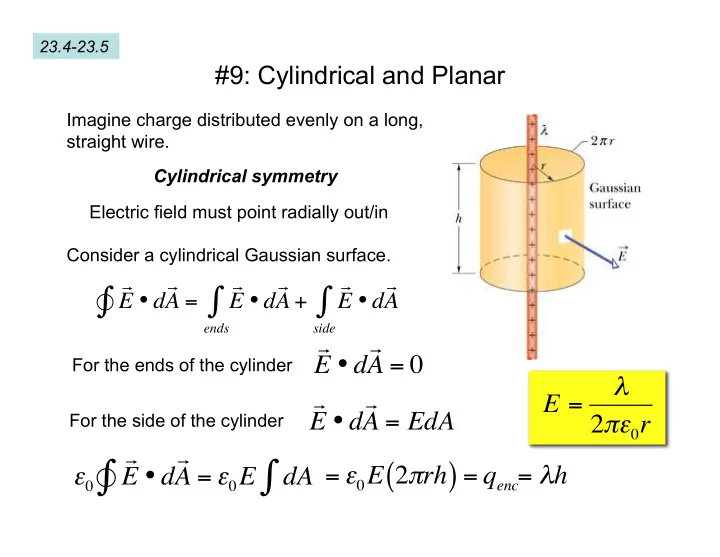

23.4-23.5 #9: Cylindrical and Planar Imagine charge distributed evenly on a long, straight wire. Cylindrical symmetry Electric field must point radially out/in Consider a cylindrical Gaussian surface. ∫ ∫ ∫ E • d A E • d A E • d A = + ends side E • d A = 0 For the ends of the cylinder λ E = For the side of the cylinder E • d A = EdA 2 πε 0 r ∫ ∫ ( ) = q enc = λ h = ε 0 E 2 π rh E • d A = ε 0 E dA ε 0
A coaxial cable can be accurately modelled as a long thin wire surrounded by an insulating material, which is then surrounded by a thin conducting shell. The plot shows the electric field as the function of distance from the center of such a coaxial cable. If the linear charge density on the cental conductor is λ , what is the linear charge density on the external conductor? A. 0 B. - λ C. -2 λ D. -3 λ E. -4 λ
Insulating sheet Consider a uniform distribution of charges in a large, flat insulating sheet Consider a cylindrical Gaussian surface ∫ ∫ ∫ ∫ E • d A E • d A E • d A E • d A = + + end − 1 end − 2 side Planar symmetry → electric field must point perpendicular to the sheet E • d A = 0 For the sides of the cylinder For the ends of the cylinder E • d A = EdA ∫ ∫ ∫ E • d A = E dA + E dA end − 1 end − 2 E = σ ∫ E • d A = 2 EA = q enc = σ A ε 0 2 ε 0
The figure below shows three plastic sheets that are large, parallel, and uniformly charged. The components of the net electric field along an x axis through the sheets are also plotted. (a) What is σ 1 ? (b) What is σ 1 + σ 2 + σ 3 A. 0 B. ε 0 E s / 2 C. ε 0 E s / 3 D. ε 0 E s / 6 E. - σ 2
Three thin non conducting sheets are shown below. What is charge density on sheet 1? A. 0 B. ε 0 E 0 / 4 C. ε 0 E 0 / 2 D. 3 ε 0 E 0 /4 +E 0 E. ε 0 E 0 -E 0
Three thin non conducting sheets are shown below. What is charge density on sheet 2? A. 0 B. ε 0 E 0 / 2 C. - ε 0 E 0 / 2 D. ε 0 E 0 +E 0 E. - ε 0 E 0 -E 0
The figure below is a section of a conducting rod of radius R 1 = 1.00 mm and length L = 10.0 m inside a thick-walled coaxial conducting cylindrical shell of radius R 2 = 10.0R 1 and the (same) length L . The net charge on the rod is Q 1 = +3.4 pC that on the shell is Q 2 = − 2.0Q 1 . What is the magnitude and direction of the electric field at r =2.0R 2 and r =5.0 R 1 ?
Two very long, thin, plastic rods lie in the z direction at (x=-a,y=0) and (x=+a,y=0). The rods carry a uniform charge density λ . Find an expression net electric field for points that lie on the y axis. At what point on the y axis is the magnitude of the electric field a maximum?
Recommend
More recommend